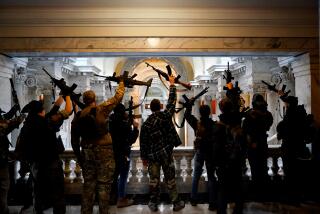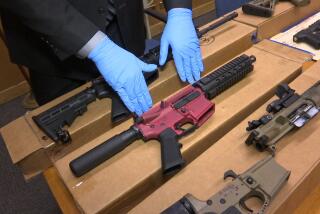More or fewer guns? The experts are divided
Two governors, a congressman, various state legislators and a host of conservative commentators joined the chief executive of the Gun Owners of America this week in suggesting that the country needs more guns, in the right hands, to prevent mass murders like the one at a Connecticut elementary school.
Such opinions strike many blue-state Americans as absurd. Gun control advocates often cite studies showing higher rates of suicide and homicide in firearms-permissive cultures, with strikingly lower rates in nations with strict controls on weapons.
But there is no scientific consensus on the effect of gun restrictions in America, and many residents of one small Georgia town say their experience bolsters the idea that putting more guns in the hands of the “good guys” will stem gun crimes.
Kennesaw, Ga., population 30,175, mandated in 1982 that “every head of household … maintain a firearm together with ammunition.”
The ordinance amounted to a pro-2nd Amendment rebuttal to Morton Grove, Ill., which had just banned handguns within its city limits. Because the Kennesaw City Council did not impose penalties, or order enforcement, the law remains mostly symbolic.
Still, the city’s website today says that “after passage of the law, the burglary rate in Kennesaw declined and even today, the city has the lowest crime rate in Cobb County,” north of Atlanta. Gun rights advocates cite the benefits as an article of faith.
Today, Kennesaw maintains a low crime rate, but not remarkably so, compared with other Georgia towns of similar size. It reported 21 violent crimes in 2011, according to the FBI’s uniform crime statistics database. That put it well below Douglasville, which recorded 179 violent crimes, but above Milton (14 violent crimes) and Peachtree City (eight violent crimes).
“It’s a deterrent,” Dent “Wildman” Myers, 81, said in an interview. “There has been a considerable lessening of any kind of criminal activity, that is for sure. That is what the statistics show.”
Myers wears a pair of .45 automatics holstered on his belt while working at his shop, Wildman’s Civil War Surplus. “I’ve been around weaponry since I was knee-high to a jack rabbit,” he said, before belittling Australia for using the “excuse” of a 1996 mass shooting that left 16 dead to launch a sharp gun crackdown.
Gun control advocates, in contrast, cite the Australian reforms as a model. After banning automatic and semiautomatic rifles in 1996 and buying back 700,000 of the newly illegal weapons, the country saw gun-related murders drop 59% over a decade.
In Kennesaw, the city’s regular spokesman on the gun issue doesn’t make any big claims. “It’s hard to say what impact the ordinance itself may have,” Police Lt. Craig Graydon said. “It seems to help some, but we’re not sure how much impact it has overall on crime.”
Georgia prohibits civilians bringing guns into schools. Since the Connecticut shooting, officials in several other states have begun to discuss allowing teachers and other school employees to carry firearms.
The small Texas town of Harrold already allows teachers who have clearance from the school board to carry concealed weapons.
Officials said they think their 5-year-old gun policy can be a deterrent, though gun control advocates warn of the danger of collateral damage from would-be defenders. A spokesman for the Washington, D.C.-based Coalition to Stop Gun Violence called the idea of arming teachers “madness.”
In a 2004 review, the National Academy of Sciences said it could reach no sure conclusions on the merits of defensive gun use. It called for more research.
Both sides in the debate have their academic champions when it comes to measuring the public safety impacts. Pro-gun advocates cite Gary Kleck, a Florida State University professor of criminology whose 1994 national survey estimated that victims used guns 2.5 million times a year in the U.S. to protect themselves. Kleck compared this favorably to the 400,000 times he said criminals used guns against victims.
“In sum,” Kleck wrote, “measures that effectively reduce gun availability among the non-criminal majority also would reduce [defensive gun uses] that otherwise would have saved lives, prevented injuries, thwarted rape attempts, driven off burglars, and helped victims retain their property.”
A 1992 report from the U.S. Justice Department’s statistical unit reached a different conclusion. It identified 667,000 handgun crimes a year over a five-year period and found 83,000 victims a year who used a firearm to defend themselves.
Kleck argued that the national government surveys underestimate gun defenses, but other academics charge that his survey vastly overstates them. David McDowall, a criminology professor at the State University of New York at Albany, said the Kleck survey reported on not just crime victims but, among others, those who believed a gun protected them when they merely felt threatened.
The two academics, no surprise, also disagreed on the meaning of Kennesaw’s gun law.
Kleck noted a decrease in burglaries in the seven months after passage of the law, compared with the same months the previous year. McDowall looked at a longer period. He found 35 burglaries a year in two full years preceding the ordinance and 35 burglaries a year in two years following it. No change.
“Given that half of the U.S. households own a gun, armed self-defense is extremely uncommon,” McDowall wrote of the national figures. “Coupled with the risk of keeping a gun for protection, these results raise questions about the collective benefits of civilian firearm ownership for crime control.”
The Associated Press contributed to this report.
More to Read
Sign up for Essential California
The most important California stories and recommendations in your inbox every morning.
You may occasionally receive promotional content from the Los Angeles Times.











